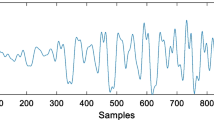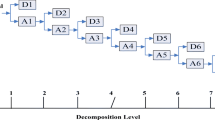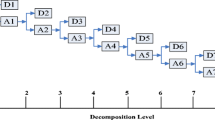Abstract
In the field of embedding digital information or private message into an audio signal, signal-to-noise ratio (SNR) and bit error rate (BER) are commonly performance indexes in measuring the distortion and robustness. The larger the value of SNR, the better the audio quality of the embedded information, and the smaller the value of BER, the more resistant the embedded information is to malicious attacks. This study first considers the unknown coefficients in the discrete wavelet transform and the unknown weights of these coefficients, as well as the state-switching embedded equations in an optimization model to embed digital information or private message. Next, Karush–Kuhn–Tucker theorem and minimum-energy approach play two essential roles to determine the unknown coefficients and the unknown weights so as to complete the information embedding or private message communication. In addition, the extraction of private message is similar to the private message embedding reversely. Finally, this study obtains an essential optimization-based system with state switching for embedding digital information or private message into an audio signal. Experimental results verify that the embedded audio in the proposed method has high SNR and low BER, indicating strong robustness against various attacks, such as re-sampling, amplitude scaling, and mp3 compression.

















Similar content being viewed by others
Data availability
All test audios are paid for by the authors.
7. References
A.-H. Ali, An imperceptible and robust audio watermarking algorithm. EURASIP J. Audio Speech Music Process. (2014). https://doi.org/10.1186/s13636-014-0037-2
A.A. Attari, A.A.B. Shirazi, Robust audio watermarking algorithm based on DWT using Fibonacci numbers. Multimedia Tools and Applications 77(2018), 25607–25627 (2018)
C.S. Burrus, R.A. Gopinath, H. Gao, Introduction to wavelet theory and its application (Prentice-Hall, New Jersey, 1998)
S.-T. Chen, C.-Y. Hsu, H.-N. Huang, Wavelet-domain audio watermarking using optimal modification on low-frequency amplitude. IET Proc. Signal Proc. 9(2), 166–176 (2015)
S.-T. Chen, H.-N. Huang, Optimization-based audio watermarking with integrated quantization embedding. Multimedia Tools Appl. 75(8), 4735–4751 (2016)
S.-T. Chen, H.-N. Huang, C.-C. Chen, K.-K. Tseng, S.-Y. Tu, Adaptive audio watermarking via the optimization point of view on wavelet-based entropy. Digital Signal Proc 23(3), 971–980 (2013)
S.-T. Chen, H.-N. Huang, C.-J. Chen, G.-D. Wu, Energy-proportion based scheme for audio watermarking. IET Signal Proc. 4(5), 576–587 (2010)
E.K.P. Chong, S.H. ZAK, An introduction to optimization (John Wiley and Sons Inc, New York, 2001)
P.K. Dhar, T. Shimamure, Blind audio watermarking in transform domain based on singular value decomposition and exponential-log operations. Radioengineering 2017(26), 552–561 (2017)
P. Hu, D. Peng, Z. Yi, Y. Xiang, Robust time-spread echo watermarking using characteristics of host signals. IET Electr. Lett. 52(1), 5–6 (2016)
H.-N. Huang, S.-T. Chen, M.-S. Lin, W.-M. Kung, C.-Y. Hsu, Optimization-based embedding for wavelet-domain audio watermarking. J. Signal Proc. Syst. 80(2), 197–208 (2015)
Y. Huang, S. Tang, C. Bao, Y.-J. Yip, Steganalysis of compressed speech to detect covert Voice over Internet Protocol channels. IET Inf. Secur. 5(1), 26–32 (2011)
IFPI (International Federation of the Phonographic Industry), http://www.ifpi.org
M. Jeyhoon, M. Asgari, L. Ehsan, S. Jalilzadeh, Blind audio watermarking algorithm based on DCT, linear regression and standard deviation. Multimedia Tools Appl. 76(3), 3343–3359 (2016)
S. Katzenbeisser Petitcolas Information Hiding Techniques for Steganography and Digital Watermarking (1999) https://doi.org/10.1201/1079/43263.28.6.20001201/30373.5
F.L. Lewis, Optimal control (John Wiley and Sons, New York, 1986)
J.-F. Li, H.-X. Wang, T. Wu, X.-M. Sun, Q. Qian, Norm ratio-based audio watermarking scheme in dwt domain. Multimedia Tools Appl 77(12), 14481–14497 (2018)
R. Li, S. Xu, H. Yang, Spread spectrum audio watermarking based on perceptual characteristic aware extraction. IET Signal Proc. 10(3), 266–273 (2016)
H. Liu, J. Liu, X. Yan, P. Xue, S. Wan, L. Li, Centroid-based audio steganography scheme in wavelet domain. J Inf Hiding Multimedia Signal Proc. 9(5), 1222–1232 (2018)
Mallat, S.: A theory for multiresolution signal decomposition: the wavelet representation, IEEE. Trans. Pattern Anal. Mach. Intel., 11, 674–693, 1989.
I. Natgunanathan, Y. Xiang, Y. Rong, D. Peng, Robust patchwork-based watermarking method for stereo audio signals. Multimedia Tools Appl. 72, 1387–1410 (2014)
M. Nutzinger, Real-time attacks on audio steganography, journal of information hiding and multimedia. Signal Proc. 3(1), 47–65 (2012)
I. Orovic, P. Zogovic, N. Zaric, S. Stankovi, Speech Signals Protection via Logo Watermarking based on the Time-Frequency Analysis. Annal. des Telecommun. 63(6), 276–284 (2008)
PEAQ information from OPTICOM http://www.opticom.de/technology/technology.html.
PQevalAudioMatlab and C implementation of PEAQ Basic Model http://www-mmsp.ece.mcgill.ca/Documents/Software/index.html
H.S. Saini, D. Arora, M. Verma, An effective audio watermarking approach with high data embedding. Int. J. Innov. Technol. Explor. Eng. 8(4), 185–219 (2019)
Salovarda, M., Bolkovac, I., Domitrovic, H.:. Estimating perceptual audio system quality using PEAQ algorithm,” 18 th Int. Conf. Appl. Electromagnet. Commun., pp. 1–4, October, 2005.
A. Singha, M.A. Ullah, Development of an audio watermarking with decentralization of the watermarks. J. King Saud Univ. Comput. Inf. Sci. (2020). https://doi.org/10.1016/j.jksuci.2020.09.007
T.K. Tewari, V. Saxena, J.P. Gupta, A digital audio watermarking algorithm using selective mid band DCT coefficients and energy threshold. Int. J. Speech Technol. 17, 365–371 (2014)
K. Vivekananda Bhat, A.K. Das, J.‐H. Lee, Design of a blind quantization‐based audio watermarking scheme using singular value decomposition. Concurr. Comput. Pract. Exp., 32(18), (2019).
X.Y. Wang, Q.L. Shi, S.M. Wang, H.Y. Yang, A blind robust digital watermarking using invariant exponent moments. Int. J. Electron. Commun. 70, 416–426 (2016)
S. Wang, C. Wang, W. Yuan, L. Wang, J. Wang, Secure echo-hiding audio watermarking method based on improved PN sequence and robust principal component analysis. IET Signal Proc. 14(4), 229–242 (2020)
Q. Wu, M. Wu, A novel robust audio watermarking algorithm by modifying the average amplitude in transform domain. Appl. Sci. 8(723), 1–17 (2018)
S.-J. Xiang, Z.-H. Li, Reversible audio data hiding algorithm using noncausal prediction of alterable orders. EURASIP J. Audio Speech Music Proc. 4, 2017 (2017)
S.-J. Xiang, Z.-H. Li, Reversible audio data hiding algorithm using noncausal prediction of alterable orders. EURASIP J. Audio Speech Music Proc. (2017). https://doi.org/10.1186/s13636-017-0101-9
A.U. Yargıçıoğlu, H.G. İlk, Hidden data transmission in mixed excitation linear prediction coded speech using quantisation index modulation. IET Inf. Secur. 4, 158–166 (2010). https://doi.org/10.1049/iet-ifs.2009.0092
M. Zhao, J.-S. Pan, S.-T. Chen, Entropy-based audio watermarking via the point of view on the compact particle swarm optimization. J. Int. Technol. 16(3), 485–495 (2015)
Acknowledgements
The authors would like to sincerely thank the Editor and anonymous reviewers for their thoughtful and valuable comments, which have significantly improved the quality of this paper. The authors are partially supported by the National Science and Technology Council of Taiwan under the grant 110-2410-H-182-008-MY3.
Funding
No funding.
Author information
Authors and Affiliations
Contributions
S-TC contributed to conceptualization; MZ was involved in methodology; S-TC and HL provided software; S-T C and MZ contributed to validation; S-TC and H-CL were involved in writing—review and editing; and all authors have read and agreed to the published version of the manuscript.
Corresponding author
Ethics declarations
Competing interests
The authors declare no competing interests.
Additional information
Publisher's Note
Springer Nature remains neutral with regard to jurisdictional claims in published maps and institutional affiliations.
Appendices
Appendix I
Multiply (18a) by \({\mathbf{W}}\) and rewrite (18b), we have
Replacing (19b) to (19a), we have
Hence, the optimal solution for the multiplier \(\lambda_{1}\) is
Replacing (21) to (18a), the optimal DWT coefficients are
Appendix II
Use the fact that \({\hat{\mathbf{C}}}_{N}^{*} = {\mathbf{C}}_{N} - {\mathbf{W}}^{T} ({\mathbf{WW}}^{T} )^{ - 1} \left[ {{\mathbf{WC}}_{N} - \frac{{(1 - \alpha )\gamma_{0} - \alpha \gamma_{1} }}{1 - 2\alpha }} \right]\), the term \(\frac{{\left( {{\hat{\mathbf{C}}}_{N}^{*} - {\mathbf{C}}_{N} } \right)^{T} \left( {{\hat{\mathbf{C}}}_{N}^{*} - {\mathbf{C}}_{N} } \right)}}{{{\mathbf{C}}_{N}^{T} {\mathbf{C}}_{N} }}\)can be simplified as \(\frac{1}{{\left( {\sum\limits_{j = 1}^{N} {w_{j}^{2} } } \right)\left( {\sum\limits_{j = 1}^{N} {\left| {c_{j} } \right|^{2} } } \right)}}\left\{ {\sum\limits_{j = 1}^{N} {w_{j} } \left| {c_{j} } \right| - \frac{{(1 - \alpha )\gamma_{0} - \alpha \gamma_{1} }}{1 - 2\alpha }} \right\}^{2}\)
In other words, the optimization model above can be rewritten as:
In order to minimize \(\frac{1}{{\left( {\sum\limits_{j = 1}^{N} {w_{j}^{2} } } \right)\left( {\sum\limits_{j = 1}^{N} {\left| {c_{j} } \right|^{2} } } \right)}}\left\{ {\sum\limits_{j = 1}^{N} {w_{j} } \left| {c_{j} } \right| - \frac{{(1 - \alpha )\gamma_{0} - \alpha \gamma_{1} }}{1 - 2\alpha }} \right\}^{2}\) subject to \(\sum\limits_{j = 1}^{N} {w_{j} } = M,\) we set
Then, the necessary condition \(\frac{{\partial H_{2} }}{{\partial w_{k} }} = 0,\quad k = 1,2, \ldots ,N\) implies
That is, the optimal solution for \(\lambda\) is
or
\({\text{If }}w_{k} \frac{{\sum\limits_{j = 1}^{N} {w_{j} \left| {c_{j} } \right|} - \frac{{(1 - \alpha )\gamma_{0} - \alpha \gamma_{1} }}{1 - 2\alpha }}}{{\sum\limits_{j = 1}^{N} {w_{j}^{2} } }} - \left| {c_{k} } \right|\) is a constant for all \(k\); then, \(|c_{1} | = |c_{2} | = \cdots = |c_{N} |\). However, the case \(|c_{1} | = |c_{2} | = \cdots = |c_{N} |\) is not always true in DWT, respectively. Hence, we consider the other case
Since \(w_{N} = M - \sum\limits_{j = 1}^{N - 1} {w_{j} }\), we rewrite (26) as
i.e.,
Since \(N - 1\) unknowns are contained in one equation, infinitely many numbers of solutions are there to (28) and such equation should be resolved using the minimum-energy method. Assume
then Eq. (28) can be expressed as \({\mathbf{Px}} = b\). The minimum-energy solution is given by \({\mathbf{x}}_{ + } = {\mathbf{P}}^{T} v\) where \(v\) satisfies \({\mathbf{PP}}^{T} v = b\). Through algebraic operations, we have
Thus, the optimal solutions of weights are
and
Suppose that all \(w_{j}^{\prime } s\) in (29) and (30) are positive, existence of an optimal solution to the system of linear equations in (26) is guaranteed; if some \(w_{j}^{\prime } s\left[ {0,1} \right]\) are either negative or zero, an optimal solution does not exist and a near optimal solution will be searched instead. In the case of \(w_{k} \le 0{\text{ for some }}k\), which occurs when the signs of \(\left| {c_{k} } \right| - \left| {c_{N} } \right|\) and \(\frac{{(1 - \alpha )\gamma_{0} - \alpha \gamma_{1} }}{1 - 2\alpha } - M\left| {c_{N} } \right|\) in (29) and (30) are opposite, we have
indicating either \({\raise0.7ex\hbox{${\frac{{(1 - \alpha )\gamma_{0} - \alpha \gamma_{1} }}{1 - 2\alpha }}$} \!\mathord{\left/ {\vphantom {{\frac{{(1 - \alpha )\gamma_{0} - \alpha \gamma_{1} }}{1 - 2\alpha }} M}}\right.\kern-0pt} \!\lower0.7ex\hbox{$M$}} < \left| {c_{N} } \right| < \left| {c_{k} } \right|or\left| {c_{k} } \right| < \left| {c_{N} } \right| < {\raise0.7ex\hbox{${\frac{{(1 - \alpha )\gamma_{0} - \alpha \gamma_{1} }}{1 - 2\alpha }}$} \!\mathord{\left/ {\vphantom {{\frac{{(1 - \alpha )\gamma_{0} - \alpha \gamma_{1} }}{1 - 2\alpha }} M}}\right.\kern-0pt} \!\lower0.7ex\hbox{$M$}}\) or holds.
Assume that \(sign(\left| {c_{j} } \right| - \left| {c_{N} } \right|) = sign(\frac{{(1 - \alpha )\gamma_{0} - \alpha \gamma_{1} }}{1 - 2\alpha } - M\left| {c_{N} } \right|),{\text{ for }}1 \le j\not = k \le N\), then \(\left| {c_{k} } \right|\) is either the largest or smallest absolute DWT coefficients \({\mathbf{C}}_{N}\) depending on whether \({\raise0.7ex\hbox{${\frac{{(1 - \alpha )\gamma_{0} - \alpha \gamma_{1} }}{1 - 2\alpha }}$} \!\mathord{\left/ {\vphantom {{\frac{{(1 - \alpha )\gamma_{0} - \alpha \gamma_{1} }}{1 - 2\alpha }} M}}\right.\kern-0pt} \!\lower0.7ex\hbox{$M$}} < \left| {c_{N} } \right|{\text{or}}\left| {c_{N} } \right| < {\raise0.7ex\hbox{${\frac{{(1 - \alpha )\gamma_{0} - \alpha \gamma_{1} }}{1 - 2\alpha }}$} \!\mathord{\left/ {\vphantom {{\frac{{(1 - \alpha )\gamma_{0} - \alpha \gamma_{1} }}{1 - 2\alpha }} M}}\right.\kern-0pt} \!\lower0.7ex\hbox{$M$}}\). In order not to discredit the SNR, the DWT coefficient term \(c_{k}\) needs to be un-scaled, namely \(w_{k} = 1\), and we turn to resolve (28) for the optimal solution with other \(N - 1\) weights. If more than one weights are nonnegative, we seek for the other weights to maximize the SNR and the optimization process will be performed iteratively.
Rights and permissions
Springer Nature or its licensor (e.g. a society or other partner) holds exclusive rights to this article under a publishing agreement with the author(s) or other rightsholder(s); author self-archiving of the accepted manuscript version of this article is solely governed by the terms of such publishing agreement and applicable law.
About this article
Cite this article
Chen, ST., Lu, HC. Optimization and Minimum-Energy Approaches for Private Message Security in the Wavelet Domain of Audio Signals. Circuits Syst Signal Process 42, 7194–7225 (2023). https://doi.org/10.1007/s00034-023-02419-x
Received:
Revised:
Accepted:
Published:
Issue Date:
DOI: https://doi.org/10.1007/s00034-023-02419-x




